Effects of Graded Levels of Moringa Oleifera Leaf-Meal In Albino Rat Diet on Some Hematological Parameters
Article Information
Ari-egoro YE, Ayodele PF*, Oyeleke OM
Department of pure and Industrial Chemistry, Abia state University Uturu, Nigeria
*Corresponding Author: Ayodele Peter Folorunsho, Department of Biochemistry, Federal University of Agriculture, Abeokuta, Ogun State, Nigeria
Received: 05 May 2019; Accepted: 14 May 2019; Published: 03 July 2019
Citation: Ari-egoro YE, Ayodele PF, Oyeleke OM. Effects of Graded Levels of Moringa Oleifera Leaf-Meal In Albino Rat Diet on Some Hematological Parameters. Journal of Analytical Techniques and Research 1 (2019): 036-042.
View / Download Pdf Share at FacebookAbstract
This study was aimed at investigating the effects of Moringa oleifera leaf-meal (MOLM) on some haematological parameters of male albino rats. Sixteen (16) albino rats were randomly selected into four (4) groups; a control group (group A) and three experimental groups (groups B, group C and group D) containing four (4) animals per group. Group A was given normal diet, groups B, C and D were provided with MOLM diets containing 37.5 gm, 56 gm and 75 gm respectively. They were fed with water ad libitum daily for 21 days. At the end of the experimental period, haematological parameters (white blood cell count, packed cell volume, red blood cell count, haemoglobin count and differential white blood cells) were determined. The result showed significant differences (P<0.05) in hemoglobin count, red blood cells and packed cell volume in group B while there was a significant difference (p<0.05) in lymphocyte count of animals in group C and D, although all the groups were within normal range while no significant difference (P >0.05) was shown in the white blood cell count when compared to the control group. In conclusion, this study revealed that MOLM possesses nutritional benefits and this was indicated by its effects on RBC, PCV, haemoglobin and lymphocyte of the animals.
Keywords
Moringa oleifera leave powder, Hemoglobin count, Red blood cells, Pcv and lymphocyte count
Moringa oleifera leave powder articles, Hemoglobin count articles, Red blood cells articles, Pcv and lymphocyte count articles
Moringa oleifera leave powder articles Moringa oleifera leave powder Research articles Moringa oleifera leave powder review articles Moringa oleifera leave powder PubMed articles Moringa oleifera leave powder PubMed Central articles Moringa oleifera leave powder 2023 articles Moringa oleifera leave powder 2024 articles Moringa oleifera leave powder Scopus articles Moringa oleifera leave powder impact factor journals Moringa oleifera leave powder Scopus journals Moringa oleifera leave powder PubMed journals Moringa oleifera leave powder medical journals Moringa oleifera leave powder free journals Moringa oleifera leave powder best journals Moringa oleifera leave powder top journals Moringa oleifera leave powder free medical journals Moringa oleifera leave powder famous journals Moringa oleifera leave powder Google Scholar indexed journals Hemoglobin count articles Hemoglobin count Research articles Hemoglobin count review articles Hemoglobin count PubMed articles Hemoglobin count PubMed Central articles Hemoglobin count 2023 articles Hemoglobin count 2024 articles Hemoglobin count Scopus articles Hemoglobin count impact factor journals Hemoglobin count Scopus journals Hemoglobin count PubMed journals Hemoglobin count medical journals Hemoglobin count free journals Hemoglobin count best journals Hemoglobin count top journals Hemoglobin count free medical journals Hemoglobin count famous journals Hemoglobin count Google Scholar indexed journals Red blood cells articles Red blood cells Research articles Red blood cells review articles Red blood cells PubMed articles Red blood cells PubMed Central articles Red blood cells 2023 articles Red blood cells 2024 articles Red blood cells Scopus articles Red blood cells impact factor journals Red blood cells Scopus journals Red blood cells PubMed journals Red blood cells medical journals Red blood cells free journals Red blood cells best journals Red blood cells top journals Red blood cells free medical journals Red blood cells famous journals Red blood cells Google Scholar indexed journals Pcv and lymphocyte count articles Pcv and lymphocyte count Research articles Pcv and lymphocyte count review articles Pcv and lymphocyte count PubMed articles Pcv and lymphocyte count PubMed Central articles Pcv and lymphocyte count 2023 articles Pcv and lymphocyte count 2024 articles Pcv and lymphocyte count Scopus articles Pcv and lymphocyte count impact factor journals Pcv and lymphocyte count Scopus journals Pcv and lymphocyte count PubMed journals Pcv and lymphocyte count medical journals Pcv and lymphocyte count free journals Pcv and lymphocyte count best journals Pcv and lymphocyte count top journals Pcv and lymphocyte count free medical journals Pcv and lymphocyte count famous journals Pcv and lymphocyte count Google Scholar indexed journals medicinal agents articles medicinal agents Research articles medicinal agents review articles medicinal agents PubMed articles medicinal agents PubMed Central articles medicinal agents 2023 articles medicinal agents 2024 articles medicinal agents Scopus articles medicinal agents impact factor journals medicinal agents Scopus journals medicinal agents PubMed journals medicinal agents medical journals medicinal agents free journals medicinal agents best journals medicinal agents top journals medicinal agents free medical journals medicinal agents famous journals medicinal agents Google Scholar indexed journals haematological parameters articles haematological parameters Research articles haematological parameters review articles haematological parameters PubMed articles haematological parameters PubMed Central articles haematological parameters 2023 articles haematological parameters 2024 articles haematological parameters Scopus articles haematological parameters impact factor journals haematological parameters Scopus journals haematological parameters PubMed journals haematological parameters medical journals haematological parameters free journals haematological parameters best journals haematological parameters top journals haematological parameters free medical journals haematological parameters famous journals haematological parameters Google Scholar indexed journals nutritional value articles nutritional value Research articles nutritional value review articles nutritional value PubMed articles nutritional value PubMed Central articles nutritional value 2023 articles nutritional value 2024 articles nutritional value Scopus articles nutritional value impact factor journals nutritional value Scopus journals nutritional value PubMed journals nutritional value medical journals nutritional value free journals nutritional value best journals nutritional value top journals nutritional value free medical journals nutritional value famous journals nutritional value Google Scholar indexed journals experimental groups articles experimental groups Research articles experimental groups review articles experimental groups PubMed articles experimental groups PubMed Central articles experimental groups 2023 articles experimental groups 2024 articles experimental groups Scopus articles experimental groups impact factor journals experimental groups Scopus journals experimental groups PubMed journals experimental groups medical journals experimental groups free journals experimental groups best journals experimental groups top journals experimental groups free medical journals experimental groups famous journals experimental groups Google Scholar indexed journals experimental period articles experimental period Research articles experimental period review articles experimental period PubMed articles experimental period PubMed Central articles experimental period 2023 articles experimental period 2024 articles experimental period Scopus articles experimental period impact factor journals experimental period Scopus journals experimental period PubMed journals experimental period medical journals experimental period free journals experimental period best journals experimental period top journals experimental period free medical journals experimental period famous journals experimental period Google Scholar indexed journals Plant materials articles Plant materials Research articles Plant materials review articles Plant materials PubMed articles Plant materials PubMed Central articles Plant materials 2023 articles Plant materials 2024 articles Plant materials Scopus articles Plant materials impact factor journals Plant materials Scopus journals Plant materials PubMed journals Plant materials medical journals Plant materials free journals Plant materials best journals Plant materials top journals Plant materials free medical journals Plant materials famous journals Plant materials Google Scholar indexed journals
Article Details
1. Introduction
Plant materials as medicinal agents were mentioned in historical documents dating back many thousands of years Rasonavivo et al. [1] and from time immemorial, humans have remained dependent on plants for medicine. From a historical reports, it shows the evident that the fascination for plants as medicine is as old as mankind. Currently, medicinal plants were reported to be used against wide arrays of health problems which include cold, cough, stomach ache, cataract, constipation and many other ailments [2]. The plant Moringa oleifera as one of these plants was reported to prevent effectively, structural changes and oxidative damage in lens of rats by enhancing the activities of enzymatic anti-oxidants, reducing the level of lipid peroxidation and inhibiting the formation of free radicals or reactive oxygen species (ROS) [3].
In addition, hematological parameters (packed cell volume, white blood cell counts, differentiation of white blood cess, haemoglobin and platelets) were also reported to be positively affected by using this plant [4]. Moreover, Moringa oleifera was found to be of a nutritional value as it contains a number of essential vitamins like vitamins A, B complex (which include B1, B3, B6 and B7), C, D, E and K [5, 6]. However, it has been used for the treatment of high blood pressure, diarrhea, intestinal worms, colon inflammation, as a diuretic agent, skin antiseptic, Lowell [7] and to maintain blood glucose level in diabetic patients [4, 8]. Moreover, M. oleifera was used as antimicrobial agent, Caceres et al. [9] to treat ulcers, Pal and Sahib [10] and to enhance the immune systems against microbial and viral infections [8]. So far, most of the work on the effects of M. oleifera were conducted on the seeds of this plant. Thus the aim of this study is to investigate the effects of the leaves of this plant on some haematological parameters (white blood cell count, packed cell volume, red blood cell count, haemoglobin count and differential white blood cells) in albino rats.
2. Materials and Methods
2.1 Chemicals and reagents
KOH and ethanol used were purchased from Bridge Biotech, Ilorin, Kwara State, Nigeria.
2.2 Plant collection and preparation
The plant Moringa oleifera fresh leaves were obtained from the compound of a house at Oke-ijetu, Osogbo. The plant was identified and the harvested moringa leaves were air-dried under a shed to obtain Moringa oleifera leaf powder (MOLP) which was kept in a plastic rubber until needed. The Blanch diet and premix were purchased from Blessing feed mill at Niyi Ibikunle Osogbo Osun state. The Moringa oleifera powder was then mixed in different proportions per test group before administration to the animals.
2.3 Experimental animal and design
A total of sixteen (16) male albino rats weighing 155.50-165.50 g were assigned into four groups per treatment. Allocation to groups was based on initial weight of the rats and group mean weight. Rats were acclimatized for a period of three weeks, afterwhich group A (Control) was given normal diet, B, C and D were provided with MOLM diets containing 37.5 gm, 56 gm and 75 gm respectively. They were fed with water ad libitum for 21 days.
2.4 Experimental diets
The basic ingredients used for the experimental (formulated) diets (per 25 kg of feed) used are shown in Table 2. Commercial vitamins and mineral premix were used solely in diet 1 (3 kg per ton of feed), diet 2 consists 37.5 gm of the vitamin-mineral premix and the other half (37.5 gm) replaced by the Moringa oleifera leaf meal. Diet 3 consists 19 gm of vitamin-mineral premix in diet and the 56 gm of Moringa oleifera leaf meal. Diet 4 contains only Moringa oleifera leaf meal (75 gm) as the sole source of vitamins and mineral premix.
2.5 Housing and feeding
In a moderate size wooden cage, four rats to a diet were housed together in a compartment in the cage. The rats were fed ad libitum maintained under normal temperature, humidity and light conditions. They were acclimatized for 21 days prior to administration of the Moringa oleifera leave meal. The experimental diets were offered in separate plastic feeders in the morning and evening (a total of 160 gm). The diets were offered daily and the feed leftover and/or wastage were weighed daily before feeding. Weights of all the animals were taken daily during the experiment. The rats were weighed one after the other, alongside with the left-over feed from each group with a weighing scale, daily at 7.00 a.m. for the 21-day period, and records kept daily.
|
Ingredients |
Quantity (Kg) |
Calculated Protein % |
Calculated Energy (Kcal/E/Kg) |
|
Maize |
500 |
5.00 |
1717 |
|
Wheat offals |
200 |
3.4 |
374 |
|
Groundnut cake |
200 |
3.2 |
528 |
|
Industrial salt |
2 |
- |
- |
|
Bone meal |
58 |
- |
- |
|
Limestone |
40 |
- |
- |
|
1000 |
16.60 |
2619 |
Protein and energy levels in feed were calculated using standard nutrient levels of feed ingredients (Feed Nutrient standards Pfizer Products Ltd. Lagos, 1989).
Table 1: Basic ingredients of the normal diet- dry matter (kg/ ton of feed).
|
Ingredients |
Diet 1 |
Diet 2 |
Diet 3 |
Diet 4 |
|
Maize |
12.50 |
12.50 |
12.50 |
12.50 |
|
Wheat offals |
5.00 |
5.00 |
5.00 |
5.00 |
|
Groundnut cake |
5.00 |
5.00 |
5.00 |
5.00 |
|
Industrial salt |
0.50 |
0.50 |
0.50 |
0.50 |
|
Bone meal |
1.00 |
1.00 |
1.00 |
1.00 |
|
Limestone |
1.50 |
1.50 |
1.50 |
1.50 |
|
Vitamin-mineral premix (gm) |
75.00 |
37.50 |
19.00 |
- |
|
Moringa oleifera leaf powder (gm) |
- |
37.50 |
56.00 |
75.00 |
|
25.58 |
25.58 |
25.58 |
25.58 |
NB: Allowances are made for losses due to milling or mixing which may be in form of dust particles.
Table 2: Basic ingredients of Moringa oleifera leave meal per 25 kg of Diet.
2.6 Collection of blood
At the end of the experiment, the rats were fasted overnight and sacrificed. Blood sample was collected via cardiac puncture after being dislocated at the cervical region, into heparinized sampling bottles. Samples were then stored in a refrigerator till when needed.
2.7 Hematological analysis
2.7.1 Erythrocyte Sedimentation Rate (ESR): A wintrobe tube was filled with blood sample and gently placed in an undisturbed place for 60 mins. The downward capillary of red blood cells in it was measured per hour as ESR.
2.7.2 Packed Cell Volume (PCV): A capillary tube was filled up with blood sample, about 75% of its length and centrifuged with a micro haematocrit centrifuge at 12,000 rpm for 5minutes.
2.7.3 Red blood cell count: 0.02 ml of blood sample was diluted with 4 ml of diluting fluid in a bijou bottle and mixed together. It was then placed counted in a counting chamber.
2.7.4 White blood cell (WBC): 0.05 ml of the blood was diluted with 0.95 ml of diluting fluid. A little portion was charged into a counting chamber to count the cells/cubic mm.
2.7.5 Haemoglobin (Hb): 0.02 ml of the blood sample was diluted with 4 ml Drabkin’s solution, mixed properly in a tube and allowed to stand for 5 mins for an observable full colour development.
2.7.6 White blood cell differential (WBC differential): Agranulocyte (lymphocytes and monocytes) and granulocytes and agranulocytes. Granulocytes (neutrophils, eosinophils and basophils). These were identified and counted after being stained with Giemsa stain. Numbers taken were recorded.
3. Results
3.1 Hematological parameters
|
Parameters |
Normal Range |
Group A Control |
Group B |
Group C |
Group D |
|
PVC (%) |
36 - 50 |
46.33 ± 4.04 |
47.67 ± 4.73? |
44.00 ± 3.61 |
44.00 ± 3.00 |
|
RBC×106/mm3 |
6.9 – 11.2 |
6.79 ± 0.02 |
8.17 ± 1.21? |
7.21 ± 0.51 |
6.97 ± 0.42 |
|
Hb g/dL |
12 - 16 |
15.67 ± 1.53 |
16.00 ± 1.73 |
14.67 ± 1.53 |
15.00 ± 1.00 |
|
WBC×103/mm3 |
4 - 10 |
8.80 ± 5.09 |
6.33 ± 0.49 |
4.07 ± 0.70 |
6.30 ± 2.29 |
|
MCHC (g/dL) |
32 - 36 |
33.79 ± 0.40 |
33.55 ± 0.82? |
33.29 ± 0.77 |
34.09 ± 0.06 |
|
DIFFERENTIAL WBCs (%) |
- |
- |
- |
- |
- |
|
Neutrophils |
40 -60 |
39.67 ± 26.27 |
28.67 ± 3.21? |
20.67 ± 6.42 |
22.00 ± 8.00 |
|
Lymphocytes |
65 - 85 |
59.00 ± 26.06 |
70.33 ± 1.53 |
76.67 ± 5.77 |
76.00 ± 7.55 |
|
Monocytes |
2 – 8 |
0.33 ± 0.53 |
0.33 ± 0.58 |
2.67 ± 1.15 |
1.33 ± 1.53? |
The results showed the haematological parameters measured, where ? indicate significant difference at level p<0.05
Table 3: Effects of Graded levels of Moringa oleifera leaf meal in albino rat diet.
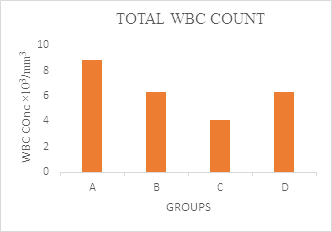
Figure 1: The effect of graded levels of Moringa oleifera in the total white blood cell count of the albino rats. Compared with the control (Group A), animals treated with 37.5 gm of Moringa oleifera (Group B) and animals treated with 75 gm of Moringa oleifera (Group D) showed decrease in white blood cells and a significant decrease (p>0.05) in WBC of animals treated with 56gm of Moringa oleifera (Group C).
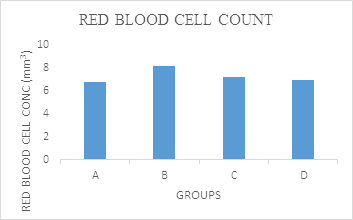
Figure 2: The effect of graded levels of Moringa oleifera in the Red blood cell of albino rat. Animals treated with 37.5 gm of Moringa oleifera (Group B) showed significant increase (p<0.05), while there was an observed slight increase in RBC of animals treated with 56 gm of Moringa oleifera (Group C) and animals treated with 75 gm of Moringa oleifera (Group D) when compared with the control (Group A).
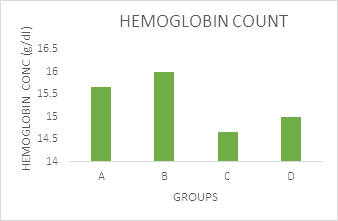
Figure 3: The effect of graded levels of Moringa oleifera in the hemoglobin count of albino rat. Animals treated with 37.5 gm of Moringa oleifera (Group B) showed a significant increase (p<0.05) in hemoglobin count, while there was a significant decrease (p?0.05) in animals treated with 56gm of Moringa oleifera (Group C) and those treated with 75 gm of Moringa oleifera (Group D) respectively.
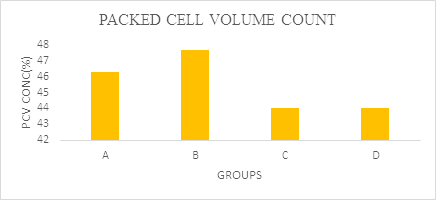
Figure 4: The effect of graded levels of Moringa oleifera in the packed cell volume count of Albino rat. Animals treated with 37.5 gm of Moringa oleifera (Group B) showed a significant increase (p<0.05) in packed cell volume, while there was a significant decrease (p>0.05) in PCV count of animals treated with 56gm of Moringa oleifera (Group C) and animals treated with 75 gm of Moringa oleifera (Group D) when compared with the control (GroupA).
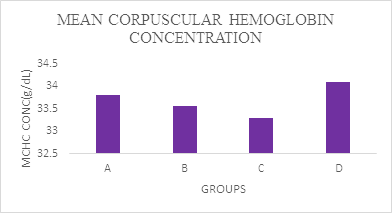
Figure 5: The effect of graded levels of Moringa oleifera in the mean corpuscular haemoglobin concentration (MCHC) of albino rats. Animals treated with 75 gm of Moringa oleifera (Group D) showed a significant increase (p<0.05), while there was a significant decrease in MCHC of animals treated with 37.5 gm of Moringa oleifera (Group B) and animals treated with 56 gm of Moringa oleifera (Group C) when compared with the control (Group A).
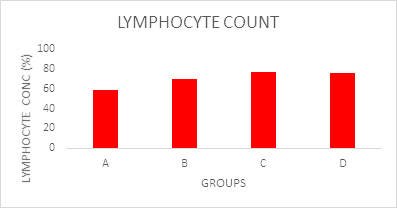
Figure 6: The effect of graded levels of Moringa oleifera in the lymphocyte count of albino rats. Animals treated with 37.5 gm of Moringa oleifera (Group B) those treated with 56 gm of Moringa oleifera (Group C) and those treated with 75gm of Moringa oleifera (Group D) showed significant increase (p<0.05) in lymphocyte count when compared to the Control group. The increase in the lymphocyte count was with increment in the amount of the Moringa oleifera respectively.
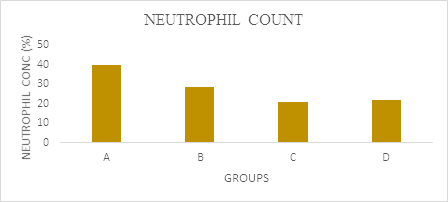
Figure 7: The effect of graded levels of Moringa oleifera on the Neutrophil count of Albino rats. Animals treated with Moringa oleifera showed a decrease in neutrophils, where animals treated with 56gm of Moringa oleifera (Group C) and animals treated with 75 gm of Moringa oleifera (Group D) showed significant a decrease (p>0.05) when compared with the control (Group A).
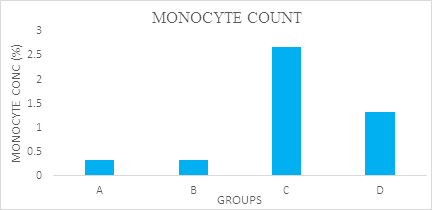
Figure 8: The effect of graded levels of Moringa oleifera in the monocyte count of albino rats. Animals treated with 56 gm of Moringa oleifera (Group C) and animal treated with 75 gm of Moringa oleifera (Group D) showed a significant increase (p<0.05) in monocyte concentration when compared with the control (Group A). Animals treated with 37.5 gm of Moringa oleifera (Group B) normalised with that of the control (Group A).
4. Discussion
Results showed that M. oleifera caused a decrease in red blood cell (RBC) in all the groups to which it was administered. The result showed increase in hemoglobin (Hb) count in animals fed with 37.5 gm of M. oleifera only. The increase in Hb count could be that MOLM enhances blood production when consumed in small portions than large portions. This observation is in agreement with earlier work reported by Adedapo et al. [11] who reported an increase in Hb count among rats given 400 mg/kg body weight of M. oleifera leave than the quantities greater than 400 mg/kg b.w. Also, Otitoju et al in his study, in which the lowest 1mg/kg body weight quantitity of M. oleifera brought about the highest Hb count. Similarly, the result showed increase in PCV in animals feed with 37.5 gm of M. oleifera. This increase suggests that Moringa Oleifera leaves could promote blood formation in anaemic patients. This result suggests the local use of this plant as blood booster in anaemic patients.
However, the result showed a decrease in white blood cells in all the concentrations used, this may infer nutritional deficiency of vitamins B9 and B12, this observation is supported by work reported by Fahey [12] in which M. oleifera nutritional properties does not include the presence of vitamin B9 and B12. However mean values of all the groups which fed on graded levels of M. oleifera leave meal were within the range of 4 ×103/mm3 to 1 ×104/mm3.
Results showed that M. oleifera at 37.5 gm, 56.0 gm and 75.0 gm caused increase in the level of lymphocyte count in all the test groups. This observation showed the function of differential white blood cell (Lymphocyte) to defend against invading microorganisms. This study suggests that the consumption of M. oleifera leaves at small quantity seems better. Lymphocytes are produced naturally by the body system in response to any foreign substances in the body. In order to avoid induction of lymphocytes, minimum quantities which are sufficient to perform the nutritional and/or therapeutic function by which it is used for must be taken into consideration during consumption. It is recommended that further studies are conducted to be sure of the best or optimum levels at which the most health and metabolic benefits can be derived.
5. Conclusion
The results of this study thus support some investigations conducted on M. oleifera, that it possess medicinal effects on some nutritional diseases like anaemia [13]. This was indicated in this study by the effect of the MO on RBC, PCV, haemoglobin and lymphocyte of the albino rats. It also indicates the ability of M. oleifera to cause shedding of weight.
6. Suggestion
It is suggested that more research be carried out to investigate the synergistic effect of Moringa oleifera on haematological parameters especially using graded level to ascertain the exert dose healthy for consumption to promote desired performance characteristics.
References
- Rasonavivo P, Petitjeanm A, Ratsimamanga P, et al. Medicinal plants used to treat malaria in Madagascar. J Ethnopharacol 37 (1992): 117-127.
- Jimenez-Arellanes A, Meckes M, Ramireez R, et al. Activity against multidrug-resistant mycobacterium tuberculosis in Mexican plants used to treat respiratory diseases. J Phytother Res 17 (2003): 903-908.
- Sreelatha S, Padma PR. Antioxidant activity and total phenolic content of Moringa oleifera leaves in two stages of maturity. J Plant Food Human Nutri 64 (2009): 303-311.
- Chinwe C, Isitua N. Studies on the haematological impact of Moringa oleifera in rabbits. A poster presented at 2nd Internationals Conference on Applied Biotechnology, Khartoum, Sudan (2010): 25-27.
- Dorga P, Sngh D, Tandon S. Vitamin content in Moringa. J Current Sci 44 (1975): 30-31.
- Booth FE, Wickens GE. Non-timber uses of selected arid zone trees and shrubs in Africa. FAO conservation guide (1988): 92-101.
- Lowell J, Fuglie. The Miracle Tree. ACP – EU, Dakar (2002): 137-139.
- Jaiswal D, Rai P, Kumar A, et al. Effect of Moringa oleifera Leaves aqueous extract therapy on hyperglycemic rats. J Ethnopharmacol 123 (2009): 392-396.
- Caceres AO, Cabrera O, Morales P. Pharmaceutical properties of oleifera. Preliminary screening for antimicrobial activity, J. Ethnopharmacol 33 (1990): 213-216.
- Pal SM, Sahib P. Studies on anti-ulcer activity of oleifera leaves extract on gastric ulcer models in rats. J Phytotherpy Res 9 (1995): 463-465.
- Adedapo AA, Mogbojuri OM, Emikpe BO. Safety evaluation of the aqueous extract of the leaves of Moringa Oleifera in rats. Journal of Med. plants Res 3 (2009): 586-591.
- Fahey JW. Moringa oleifera: A review of the medical evidence for its nutritional, therapeutic, and prophylactic properties. Part 1. Trees Life J 1 (2005): 5
- Price ML. The moringa Tree. ECHO technical l note. Revised edition (2007): 11-12.
